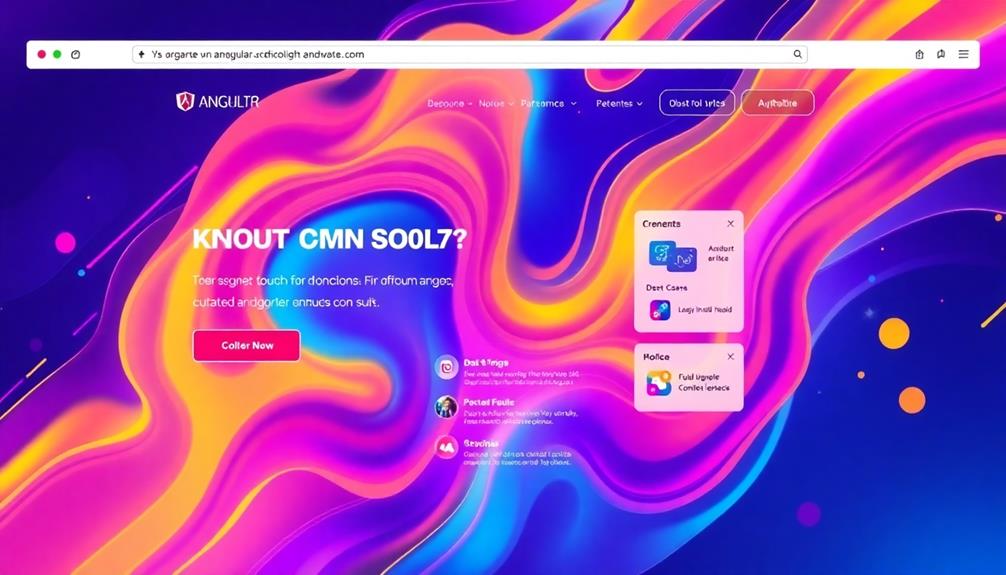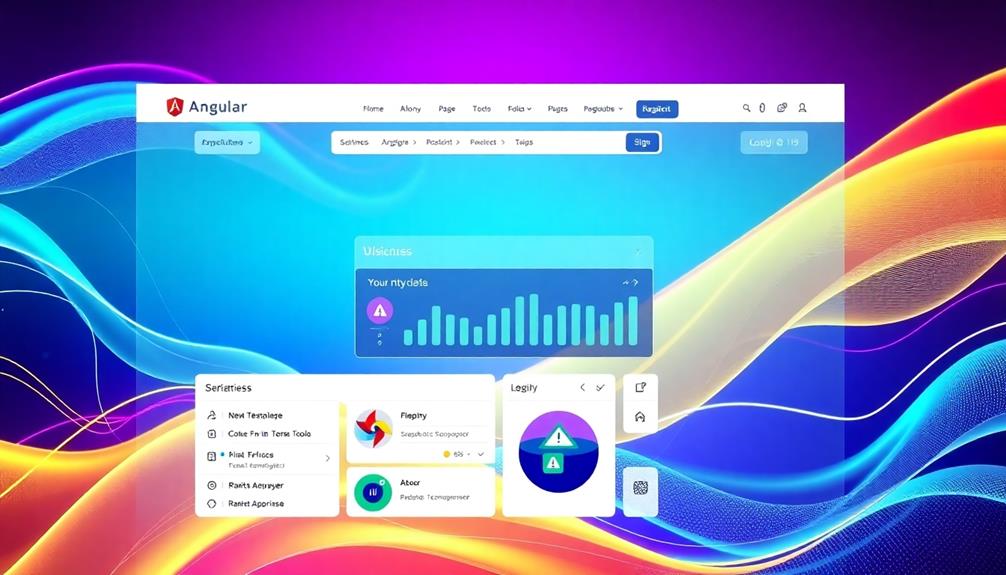You can elevate your web applications by releasing the power of Angular Single Page Applications (SPAs) for dynamic user experiences. With Angular's routing capabilities, you can create seamless navigation without traditional page reloads. Lazy loading further enhances performance by loading components on demand. Plus, you'll benefit from improved security and offline capabilities, making your app more robust. Implementing effective data management strategies using Angular services and NgRx guarantees a smooth developer experience while engaging users. As you explore the future trends in Angular SPAs, you'll uncover even more ways to enhance your applications.
Key Takeaways
- Angular SPAs offer seamless navigation by eliminating traditional page reloads, enhancing user experience.
- Employ lazy loading to improve performance by loading components only when needed, reducing initial load times.
- Utilize Angular services and RxJS observables for efficient data management and real-time updates across your application.
- Implement Angular Universal for server-side rendering, improving SEO and ensuring your application is easily indexed by search engines.
- Leverage reusable components with Angular Material to create a cohesive and responsive design across various devices.
Overview of Angular SPAs

When you think about modern web applications, Angular Single Page Applications (SPAs) stand out for their ability to deliver a smooth and efficient user experience. SPAs enhance this experience by eliminating traditional page reloads, allowing for seamless navigation between components. This architecture significantly reduces loading times, creating an app-like feel that users appreciate. Developers aiming to master Angular for SingleSPA can further leverage its modular framework to build scalable, maintainable, and robust applications. By integrating Angular with frameworks like SingleSPA, teams are empowered to craft micro-frontends that enable independent development and deployment of different application modules.
With Angular's routing capabilities, you can easily manage multiple views within a single application context. Performance is boosted through techniques like lazy loading, which loads only necessary components as users interact with the app. Additionally, tree shaking minimizes the application bundle size by removing unused code, ensuring your interface remains fast and responsive.
However, mastering Angular routing is essential for effectively managing views and addressing challenges like client-side routing complexity and browser history.
Benefits of Using Angular SPAs

Angular SPAs offer a range of benefits that greatly enhance both performance and user experience.
You'll enjoy faster loading times since the application only needs to load once, allowing for smooth interactions as users navigate through different sections. This dynamic nature reduces server load by optimizing data retrieval, making your app more scalable and cost-effective.
Additionally, the offline capabilities of SPAs mean users can access certain features without an internet connection, further improving engagement.
Security is also a strong point; Angular SPAs provide better protection against common vulnerabilities.
Plus, they're optimized for mobile devices, ensuring a responsive design that looks great on any screen.
Essential Features of Angular SPAs

Single Page Applications (SPAs) built with Angular come equipped with essential features that greatly enhance usability and performance.
These features streamline your development process while providing users with a smooth experience. Here are some key highlights:
- Dynamic Routing: Navigate between views without reloading the entire page, maintaining context and improving speed.
- Lazy Loading: Load only the necessary components when needed, which reduces initial load time and improves performance.
- Component Reusability: Create reusable components that can be shared across different parts of your application, saving time and effort.
With these essential features, Angular SPAs not only enhance user engagement but also simplify the development process, allowing you to build more dynamic and responsive web applications.
Effective Data Management Strategies

Effective data management strategies are essential for building robust Angular SPAs that deliver a seamless user experience. You should leverage Angular services for centralized data access, guaranteeing components share data effectively.
Utilize RxJS observables to handle asynchronous data streams, allowing your app to respond dynamically to user interactions. Implementing NgRx Store can help you manage application state in a predictable manner, reducing complexity as your app scales.
Consider using Local Storage to persist user data across sessions, enhancing usability. Additionally, keep an eye on Angular's change detection mechanism, which confirms that your UI reflects the latest state changes.
Popular Tools for Angular Development

When diving into Angular development, you'll want to tap into a variety of popular tools that can streamline your workflow and enhance your projects.
These tools not only improve efficiency but also help you create visually appealing and responsive applications. Here are some must-have resources for your Angular toolkit:
- Angular Material: It offers a set of reusable UI components that adhere to Material Design principles, ensuring a consistent look and feel across your application.
- NgRx: This library helps you manage state predictably, making your application's data flow more manageable and maintainable.
- RxJS: It's essential for handling asynchronous data streams, allowing you to build reactive applications with ease.
SEO Techniques for SPAs

To boost your SEO strategy for Angular SPAs, you can't overlook the importance of proper indexing and visibility.
Start by implementing Angular Universal for server-side rendering (SSR), which generates static HTML for search engines to crawl effectively. Use dynamic rendering techniques to serve pre-rendered content to bots while delivering the SPA experience to users.
Make sure to manage your application's metadata accurately with Angular's built-in tools, ensuring search engines can index your pages correctly. Optimize your URLs by making them descriptive and user-friendly.
Future Trends in Angular SPAs

As you look to the future of Angular SPAs, several trends are set to shape the landscape.
First, the rise of micro-frontends will allow you to develop and deploy SPAs in a more modular fashion, enhancing team collaboration.
Next, server-side rendering (SSR) will become increasingly important for improving SEO and initial load times.
Finally, the integration of artificial intelligence will personalize user experiences, offering tailored content and recommendations.
- Enhanced micro-frontend architectures for better scalability
- Increased adoption of server-side rendering for improved performance
- AI-driven personalization to elevate user engagement
Staying ahead of these trends will empower you to build more dynamic and efficient Angular SPAs, ensuring you meet the evolving demands of users.
Frequently Asked Questions
What Are the Best Practices for Testing Angular SPAS?
When testing Angular SPAs, focus on unit tests for individual components, integration tests for service interactions, and end-to-end tests for user flows. Utilize tools like Jasmine, Karma, and Protractor to guarantee reliability and performance.
How Can I Improve Performance in Large Angular SPAS?
To make your large Angular SPAs lightning-fast, you'll want to harness lazy loading, tree shaking, and AOT compilation. Optimize routing, cache wisely, and minimize bundle sizes; your users will feel the speed surge instantly!
What Are Common Security Vulnerabilities in Angular SPAS?
You should be aware of common security vulnerabilities in Angular SPAs, such as cross-site scripting (XSS), cross-site request forgery (CSRF), and insecure direct object references. Implementing proper sanitization and authentication can mitigate these risks effectively.
How Do I Migrate an Existing Application to an Angular SPA?
"Rome wasn't built in a day." To migrate your existing application to an Angular SPA, start by restructuring components, implementing routing, optimizing performance with lazy loading, and ensuring state management aligns with your new architecture.
What Browser Compatibility Issues Should I Be Aware of With Angular SPAS?
When working with Angular SPAs, you should consider browser compatibility issues like outdated browsers not supporting ES6 features, differences in CSS rendering, and potential performance discrepancies. Always test across multiple browsers to guarantee functionality and appearance.
Conclusion
In summary, embracing Angular SPAs is like stepping into a vibrant garden of web development possibilities. You're not just planting seeds; you're cultivating an immersive experience that blossoms into seamless navigation and engaging interactions. As you navigate this landscape, remember that the right techniques and tools are your sunlight and water, nurturing your applications to flourish. So go ahead, release your creativity and watch your digital garden thrive, enchanting users and keeping them coming back for more.









